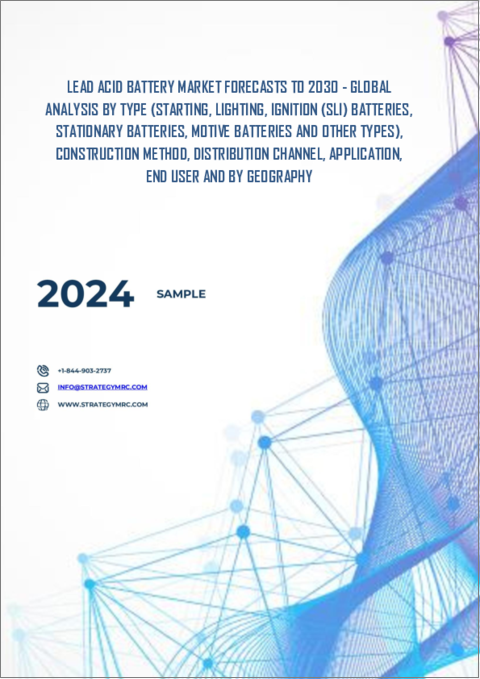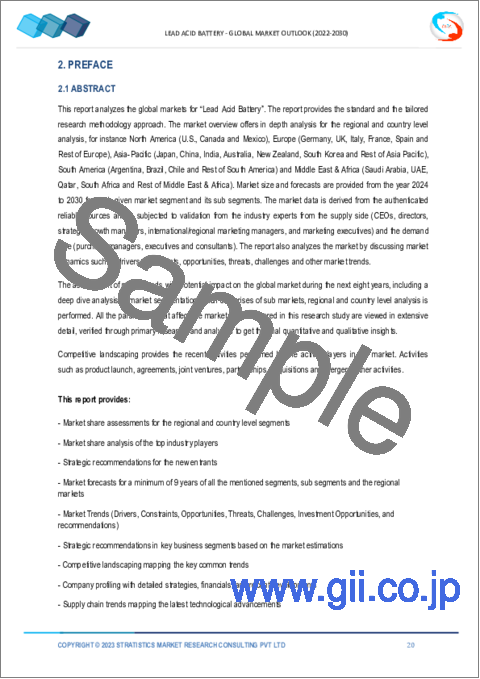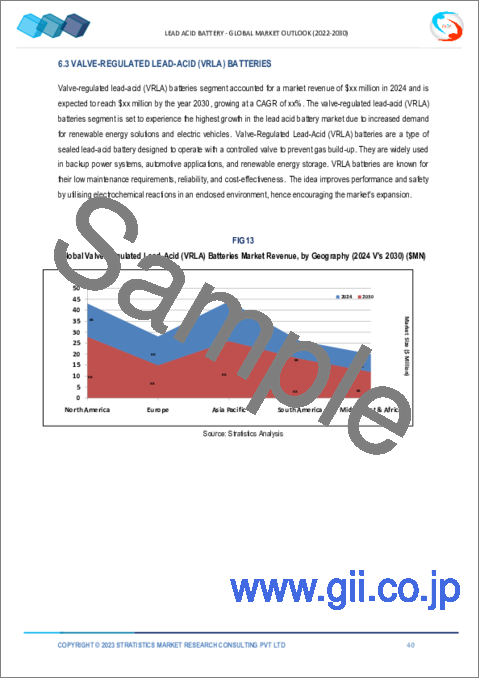|
|
市場調査レポート
商品コード
1569785
鉛蓄電池市場の2030年までの予測:タイプ別、工法別、流通チャネル別、用途別、エンドユーザー別、地域別の世界分析Lead Acid Battery Market Forecasts to 2030 - Global Analysis By Type (Starting, Lighting, Ignition Batteries, Stationary Batteries, Motive Batteries and Other Types), Construction Method, Distribution Channel, Application, End User and By Geography |
||||||
カスタマイズ可能
|
|||||||
| 鉛蓄電池市場の2030年までの予測:タイプ別、工法別、流通チャネル別、用途別、エンドユーザー別、地域別の世界分析 |
|
出版日: 2024年10月10日
発行: Stratistics Market Research Consulting
ページ情報: 英文 200+ Pages
納期: 2~3営業日
|
全表示
- 概要
- 図表
- 目次
Stratistics MRCによると、世界の鉛蓄電池市場は2024年に483億米ドルを占め、2030年にはCAGR 7.0%で成長し724億米ドルに達すると予測されています。
鉛蓄電池は二次電池の一種で、正極に二酸化鉛、負極にスポンジ鉛を使用し、硫酸電解液に浸して使用します。耐久性と費用対効果の高さで知られ、自動車用、無停電電源装置、再生可能エネルギー・システムなどによく使用されています。可逆的な化学反応によって作動するため、何度も充電することができます。
IEAによると、再生可能エネルギー発電は世界の発電量の70%以上を占めると推定されています。インドなどの発展途上国では、2022年の再生可能エネルギー発電の目標は175GWだったが、さらに217GWに修正されました。
成長する自動車部門
成長する自動車部門は、主にその信頼性と費用対効果により、需要を大きく牽引しています。電気自動車(EV)やハイブリッド車が普及するにつれて、鉛蓄電池は従来の自動車で始動、照明、点火(SLI)用途に重要な役割を果たし続けています。さらに、電池技術の進歩により性能が向上し、自動車のさまざまなニーズに適しています。このような自動車生産の急増と効率的なエネルギー貯蔵ソリューションへのニーズが、市場の成長を後押ししています。
代替技術との競合
リチウムイオン電池や固体電池などの代替技術との競合は、市場に大きな課題を投げかけています。これらの新技術は、より高いエネルギー密度、軽量、より速い充電時間などの利点を提供し、性能向上を求める消費者や業界にアピールしています。さらに、鉛蓄電池が時代遅れであるという認識は、投資と技術革新を妨げ、急速に進化するエネルギー情勢における鉛蓄電池の長期的な存続可能性に影響を与える可能性があります。
再生可能エネルギーの統合
再生可能エネルギーの統合は、市場でますます重要になってきています。鉛蓄電池は、太陽光発電や風力発電システムに不可欠な蓄電ソリューションを提供するからです。生産量のピーク時に発生する余剰エネルギーを貯蔵する能力により、発電量の少ない時間帯でも安定した電力供給が可能になります。鉛蓄電池は、特にオフグリッド・アプリケーションにおいて、エネルギー貯蔵のためのコスト効率と信頼性の高い選択肢を提供します。持続可能なエネルギー・ソリューションの推進が続く中、再生可能エネルギーの統合をサポートする鉛蓄電池の役割は拡大すると予想されます。
性能の限界
市場における性能の限界には、リチウムイオン電池のような新しい技術に比べて相対的に低いエネルギー密度と短いサイクル寿命が含まれます。また、重量が重くかさばるため、軽量ソリューションが必要なアプリケーションの妨げになることもあります。さらに、鉛蓄電池は温度変動の影響を受けやすく、効率と寿命に影響を与える可能性があります。このような制限に加え、充電時間が遅く、適切なメンテナンスが行われないとサルフェーションが発生しやすいため、先進的なアプリケーションでの利用が制限され、競争力を維持するためにはメーカーの技術革新が不可欠です。
COVID-19の影響:
この市場は様々な分野、特に自動車と再生可能エネルギーに大きな影響を与えます。これらのバッテリーは自動車に信頼性の高い電力を供給し、始動、照明、点火システムの機能を確保します。再生可能エネルギーでは、エネルギー貯蔵において重要な役割を果たし、太陽光発電や風力発電の統合を促進します。しかし、鉛の毒性やリサイクルに関する環境問題が課題となっています。全体として、市場の進化は、経済的ニーズと持続可能性および安全性への配慮のバランスをとりながら、エネルギー転換の取り組みにとって極めて重要です。
据置型電池セグメントが予測期間中最大になると予測される
据置型電池分野は、予測期間中最大の市場シェアを占めると予測されます。これらの電池は信頼性の高いバックアップを提供し、再生可能資源からの余剰エネルギーを貯蔵することでグリッドの安定性をサポートします。その堅牢性と費用対効果から、重要インフラ用として人気があります。しかし、リチウムイオンのような技術が普及するにつれて、鉛蓄電池分野は、進化するエネルギー情勢の中で競争力を維持するために、効率と寿命の改善に注力しなければならないです。
予測期間中にCAGRが最も高くなると予想される住宅用セグメント
住宅用セグメントは、予測期間中のCAGRが最も高くなると予想されます。これらの電池は、日中に発電した余剰エネルギーを夜間や停電時に使用するために蓄え、エネルギーの独立性と信頼性を高める。手頃な価格と実証済みの技術により、特に非電化環境での住宅用途に魅力的です。しかし、持続可能なエネルギー・ソリューションへの関心が高まるにつれ、市場はより効率的なバッテリー技術との競合に直面し、技術革新と性能向上の必要性が生じています。
最大のシェアを占める地域:
予測期間中、北米地域が市場で最大のシェアを占めると予想されます。自動車メーカーの存在感が大きく、電気自動車の普及が進んでいるため、市場は始動、照明、点火(SLI)用途に不可欠な存在であり続けています。さらに、鉛蓄電池はバックアップ電源システムや再生可能エネルギー貯蔵にも広く使用されています。しかし、環境規制や先進バッテリー技術との競合が課題となっています。関連性を維持するため、市場はリサイクルと電池の性能と持続可能性の向上に注力しています。
CAGRが最も高い地域:
予測期間中、アジア太平洋地域が最も高い成長率を記録すると予想されます。産業用アプリケーションにおける鉛蓄電池の需要は高まっており、特にフォークリフトやマテリアルハンドリング機器に使用されています。その信頼性と費用対効果から、これらの用途に適しています。電気通信分野の成長と地域全体のデータセンターの設立は、鉛蓄電池が効果的に提供する信頼性の高い電源バックアップシステムの必要性を高めています。
無料カスタマイズサービス:
本レポートをご購読のお客様には、以下の無料カスタマイズオプションのいずれかをご利用いただけます:
- 企業プロファイル
- 追加市場プレーヤーの包括的プロファイリング(3社まで)
- 主要企業のSWOT分析(3社まで)
- 地域セグメンテーション
- 顧客の関心に応じた主要国の市場推計・予測・CAGR(注:フィージビリティチェックによる)
- 競合ベンチマーキング
- 製品ポートフォリオ、地理的プレゼンス、戦略的提携に基づく主要企業のベンチマーキング
目次
第1章 エグゼクティブサマリー
第2章 序文
- 概要
- ステークホルダー
- 調査範囲
- 調査手法
- データマイニング
- データ分析
- データ検証
- 調査アプローチ
- 調査情報源
- 1次調査情報源
- 2次調査情報源
- 前提条件
第3章 市場動向分析
- 促進要因
- 抑制要因
- 機会
- 脅威
- 用途分析
- エンドユーザー分析
- 新興市場
- COVID-19の影響
第4章 ポーターのファイブフォース分析
- 供給企業の交渉力
- 買い手の交渉力
- 代替品の脅威
- 新規参入業者の脅威
- 競争企業間の敵対関係
第5章 世界の鉛蓄電池市場:タイプ別
- 始動、照明、点火(SLI)電池
- 据置型電池
- 動力電池
- その他のタイプ
第6章 世界の鉛蓄電池市場:工法別
- 液式鉛蓄電池
- 制御弁式鉛蓄電池(VRLA)
- 先進鉛蓄電池
- その他の工法別
第7章 世界の鉛蓄電池市場:流通チャネル別
- オンライン販売
- 小売店
- 直接販売
第8章 世界の鉛蓄電池市場:用途別
- フォークリフト
- 重機
- 乗用車
- データセンター
- 無停電電源装置(UPS)
- その他のアプリケーション
第9章 世界の鉛蓄電池市場:エンドユーザー別
- 自動車
- 産業
- 商業
- 住宅
- 通信
- その他のエンドユーザー
第10章 世界の鉛蓄電池市場:地域別
- 北米
- 米国
- カナダ
- メキシコ
- 欧州
- ドイツ
- 英国
- イタリア
- フランス
- スペイン
- その他欧州
- アジア太平洋
- 日本
- 中国
- インド
- オーストラリア
- ニュージーランド
- 韓国
- その他アジア太平洋地域
- 南米
- アルゼンチン
- ブラジル
- チリ
- その他南米
- 中東・アフリカ
- サウジアラビア
- アラブ首長国連邦
- カタール
- 南アフリカ
- その他中東とアフリカ
第11章 主な発展
- 契約、パートナーシップ、コラボレーション、合弁事業
- 買収と合併
- 新製品発売
- 事業拡大
- その他の主要戦略
第12章 企業プロファイリング
- EnerSys
- Exide Technologies, LLC
- Panasonic Corporation
- Hitachi Chemical Co., Ltd.
- Teledyne Technologies Incorporated
- Furukawa Electric
- V-Guard
- Apex Battery
- Clarios
- HBL Power Systems
- Luminous Power Technologies
- Amara Raja Batteries Ltd.
- Nippon Battery Co., Ltd.
- Lifeline Batteries
- Luminous Power Technologies
List of Tables
- Table 1 Global Lead Acid Battery Market Outlook, By Region (2022-2030) ($MN)
- Table 2 Global Lead Acid Battery Market Outlook, By Type (2022-2030) ($MN)
- Table 3 Global Lead Acid Battery Market Outlook, By Starting, Lighting, Ignition (SLI) Batteries (2022-2030) ($MN)
- Table 4 Global Lead Acid Battery Market Outlook, By Stationary Batteries (2022-2030) ($MN)
- Table 5 Global Lead Acid Battery Market Outlook, By Motive Batteries (2022-2030) ($MN)
- Table 6 Global Lead Acid Battery Market Outlook, By Other Types (2022-2030) ($MN)
- Table 7 Global Lead Acid Battery Market Outlook, By Construction Method (2022-2030) ($MN)
- Table 8 Global Lead Acid Battery Market Outlook, By Flooded Lead-Acid Batteries (2022-2030) ($MN)
- Table 9 Global Lead Acid Battery Market Outlook, By Valve-Regulated Lead-Acid (VRLA) Batteries (2022-2030) ($MN)
- Table 10 Global Lead Acid Battery Market Outlook, By Advanced Lead-Acid Batteries (2022-2030) ($MN)
- Table 11 Global Lead Acid Battery Market Outlook, By Other Construction Methods (2022-2030) ($MN)
- Table 12 Global Lead Acid Battery Market Outlook, By Distribution Channel (2022-2030) ($MN)
- Table 13 Global Lead Acid Battery Market Outlook, By Online Sales (2022-2030) ($MN)
- Table 14 Global Lead Acid Battery Market Outlook, By Retail Stores (2022-2030) ($MN)
- Table 15 Global Lead Acid Battery Market Outlook, By Direct Sales (2022-2030) ($MN)
- Table 16 Global Lead Acid Battery Market Outlook, By Application (2022-2030) ($MN)
- Table 17 Global Lead Acid Battery Market Outlook, By Forklifts (2022-2030) ($MN)
- Table 18 Global Lead Acid Battery Market Outlook, By Heavy Machinery (2022-2030) ($MN)
- Table 19 Global Lead Acid Battery Market Outlook, By Passenger vehicles (2022-2030) ($MN)
- Table 20 Global Lead Acid Battery Market Outlook, By Data Centers (2022-2030) ($MN)
- Table 21 Global Lead Acid Battery Market Outlook, By Uninterruptible Power Supplies (UPS) (2022-2030) ($MN)
- Table 22 Global Lead Acid Battery Market Outlook, By Other Applications (2022-2030) ($MN)
- Table 23 Global Lead Acid Battery Market Outlook, By End User (2022-2030) ($MN)
- Table 24 Global Lead Acid Battery Market Outlook, By Automotive (2022-2030) ($MN)
- Table 25 Global Lead Acid Battery Market Outlook, By Industrial (2022-2030) ($MN)
- Table 26 Global Lead Acid Battery Market Outlook, By Commercial (2022-2030) ($MN)
- Table 27 Global Lead Acid Battery Market Outlook, By Residential (2022-2030) ($MN)
- Table 28 Global Lead Acid Battery Market Outlook, By Telecommunications (2022-2030) ($MN)
- Table 29 Global Lead Acid Battery Market Outlook, By Other End Users (2022-2030) ($MN)
Note: Tables for North America, Europe, APAC, South America, and Middle East & Africa Regions are also represented in the same manner as above.
According to Stratistics MRC, the Global Lead Acid Battery Market is accounted for $48.3 billion in 2024 and is expected to reach $72.4 billion by 2030 growing at a CAGR 7.0% during the forecast period. A lead-acid battery is a type of rechargeable battery that uses lead dioxide as the positive electrode and sponge lead as the negative electrode, immersed in a sulfuric acid electrolyte. Known for their durability and cost-effectiveness, these batteries are commonly used in automotive applications, uninterruptible power supplies, and renewable energy systems. They operate on a reversible chemical reaction, allowing them to be recharged multiple times.
According to IEA, renewable energy is estimated to account for more than 70% of the global electricity generation. In developing countries, such as India, the target for renewable energy generation for 2022 was 175 GW, which was further revised to 217 GW.
Market Dynamics:
Driver:
Growing automotive sector
The growing automotive sector is significantly driving the demand, primarily due to their reliability and cost-effectiveness. As electric vehicles (EVs) and hybrid vehicles gain popularity, lead-acid batteries continue to play a crucial role in traditional vehicles for starting, lighting, and ignition (SLI) applications. Additionally, advancements in battery technology are enhancing performance, making them suitable for various automotive needs. This surge in automotive production and the need for efficient energy storage solutions are bolstering the market's growth.
Restraint:
Competition from alternative technologies
Competition from alternative technologies, such as lithium-ion and solid-state batteries, poses significant challenges to the market. These newer technologies offer advantages like higher energy density, lighter weight, and faster charging times, appealing to consumers and industries seeking improved performance. Additionally, the perception of lead-acid batteries as outdated can hinder investment and innovation, impacting their long-term viability in a rapidly evolving energy landscape.
Opportunity:
Renewable energy integration
Renewable energy integration is becoming increasingly important in the market, as these batteries provide essential storage solutions for solar and wind energy systems. Their ability to store excess energy generated during peak production periods allows for a stable power supply during low generation times. Lead-acid batteries offer a cost-effective and reliable option for energy storage, especially in off-grid applications. As the push for sustainable energy solutions continues, the role of lead-acid batteries in supporting renewable energy integration is expected to grow.
Threat:
Performance limitations
Performance limitations in the market include relatively low energy density and shorter cycle life compared to newer technologies like lithium-ion batteries. Their weight and bulkiness can also hinder applications requiring lightweight solutions. Additionally, lead-acid batteries are sensitive to temperature fluctuations, which can impact efficiency and longevity. These limitations, coupled with slower charging times and a tendency for sulfation when not maintained properly, restrict their appeal in advanced applications, making it essential for manufacturers to innovate to remain competitive.
Covid-19 Impact:
The market has a significant impact on various sectors, particularly automotive and renewable energy. These batteries provide reliable power for vehicles, ensuring functionality in starting, lighting, and ignition systems. In renewable energy, they play a vital role in energy storage, facilitating the integration of solar and wind power. However, environmental concerns regarding lead toxicity and recycling practices pose challenges. Overall, the market's evolution is crucial for energy transition efforts, balancing economic needs with sustainability and safety considerations.
The stationary batteries segment is projected to be the largest during the forecast period
The stationary batteries segment is projected to account for the largest market share during the projection period. These batteries provide reliable backup and support grid stability by storing excess energy from renewable sources. Their robustness and cost-effectiveness make them popular for critical infrastructure. However, as technologies like lithium-ion gain traction, the lead-acid stationary battery segment must focus on improving efficiency and lifespan to maintain competitiveness in an evolving energy landscape.
The residential segment is expected to have the highest CAGR during the forecast period
The residential segment is expected to have the highest CAGR during the extrapolated period. These batteries store excess energy generated during the day for use at night or during outages, enhancing energy independence and reliability. Their affordability and proven technology make them appealing for residential applications, especially in off-grid settings. However, as interest in sustainable energy solutions grows, the market faces competition from more efficient battery technologies, prompting a need for innovation and performance improvements.
Region with largest share:
North America region is expected to hold the largest share of the market during the forecast period. With a significant presence of automobile manufacturers and increasing adoption of electric vehicles, the market remains vital for starting, lighting, and ignition (SLI) applications. Additionally, lead-acid batteries are widely used in backup power systems and renewable energy storage. However, environmental regulations and competition from advanced battery technologies pose challenges. To maintain relevance, the market is focusing on recycling and improving battery performance and sustainability.
Region with highest CAGR:
Asia Pacific is expected to register the highest growth rate over the forecast period. The demand for lead acid batteries in industrial applications is rising, particularly for use in forklifts and material handling equipment. Their reliability and cost-effectiveness make them suitable for these applications. The growing telecom sector and the establishment of data centers across the region are increasing the need for reliable power backup systems, which lead acid batteries provide effectively.
Key players in the market
Some of the key players in Lead Acid Battery market include EnerSys , Exide Technologies, LLC, Panasonic Corporation, Hitachi Chemical Co., Ltd., Teledyne Technologies Incorporated, Furukawa Electric, V-Guard, Apex Battery, Clarios, HBL Power Systems, Luminous Power Technologies, Amara Raja Batteries Ltd., Nippon Battery Co., Ltd., Lifeline Batteries and Luminous Power Technologies.
Key Developments:
In September 2024, Exide announced plans to launch an advanced SLI-AGM battery designed for the automotive market. This new battery technology aims to provide reliable starting power, enhanced durability, and potentially longer life compared to traditional lead-acid batteries.
In February 2024, Panasonic Energy Co., Ltd., announced it has signed a binding off-take agreement with the leading battery materials and technology company NOVONIX Limited ("NOVONIX"; Queensland, Australia) for the supply of synthetic graphite, the main component of the anodes of lithium-ion batteries used in electric vehicles (EVs).
Types Covered:
- Starting, Lighting, Ignition (SLI) Batteries
- Stationary Batteries
- Motive Batteries
- Other Types
Construction Methods Covered:
- Flooded Lead-Acid Batteries
- Valve-Regulated Lead-Acid (VRLA) Batteries
- Advanced Lead-Acid Batteries
- Other Construction Methods
Distribution Channels Covered:
- Online Sales
- Retail Stores
- Direct Sales
Applications Covered:
- Forklifts
- Heavy Machinery
- Passenger vehicles
- Data Centers
- Uninterruptible Power Supplies (UPS)
- Other Applications
End Users Covered:
- Automotive
- Industrial
- Commercial
- Residential
- Telecommunications
- Other End Users
Regions Covered:
- North America
- US
- Canada
- Mexico
- Europe
- Germany
- UK
- Italy
- France
- Spain
- Rest of Europe
- Asia Pacific
- Japan
- China
- India
- Australia
- New Zealand
- South Korea
- Rest of Asia Pacific
- South America
- Argentina
- Brazil
- Chile
- Rest of South America
- Middle East & Africa
- Saudi Arabia
- UAE
- Qatar
- South Africa
- Rest of Middle East & Africa
What our report offers:
- Market share assessments for the regional and country-level segments
- Strategic recommendations for the new entrants
- Covers Market data for the years 2022, 2023, 2024, 2026, and 2030
- Market Trends (Drivers, Constraints, Opportunities, Threats, Challenges, Investment Opportunities, and recommendations)
- Strategic recommendations in key business segments based on the market estimations
- Competitive landscaping mapping the key common trends
- Company profiling with detailed strategies, financials, and recent developments
- Supply chain trends mapping the latest technological advancements
Free Customization Offerings:
All the customers of this report will be entitled to receive one of the following free customization options:
- Company Profiling
- Comprehensive profiling of additional market players (up to 3)
- SWOT Analysis of key players (up to 3)
- Regional Segmentation
- Market estimations, Forecasts and CAGR of any prominent country as per the client's interest (Note: Depends on feasibility check)
- Competitive Benchmarking
- Benchmarking of key players based on product portfolio, geographical presence, and strategic alliances
Table of Contents
1 Executive Summary
2 Preface
- 2.1 Abstract
- 2.2 Stake Holders
- 2.3 Research Scope
- 2.4 Research Methodology
- 2.4.1 Data Mining
- 2.4.2 Data Analysis
- 2.4.3 Data Validation
- 2.4.4 Research Approach
- 2.5 Research Sources
- 2.5.1 Primary Research Sources
- 2.5.2 Secondary Research Sources
- 2.5.3 Assumptions
3 Market Trend Analysis
- 3.1 Introduction
- 3.2 Drivers
- 3.3 Restraints
- 3.4 Opportunities
- 3.5 Threats
- 3.6 Application Analysis
- 3.7 End User Analysis
- 3.8 Emerging Markets
- 3.9 Impact of Covid-19
4 Porters Five Force Analysis
- 4.1 Bargaining power of suppliers
- 4.2 Bargaining power of buyers
- 4.3 Threat of substitutes
- 4.4 Threat of new entrants
- 4.5 Competitive rivalry
5 Global Lead Acid Battery Market, By Type
- 5.1 Introduction
- 5.2 Starting, Lighting, Ignition (SLI) Batteries
- 5.3 Stationary Batteries
- 5.4 Motive Batteries
- 5.5 Other Types
6 Global Lead Acid Battery Market, By Construction Method
- 6.1 Introduction
- 6.2 Flooded Lead-Acid Batteries
- 6.3 Valve-Regulated Lead-Acid (VRLA) Batteries
- 6.4 Advanced Lead-Acid Batteries
- 6.5 Other Construction Methods
7 Global Lead Acid Battery Market, By Distribution Channel
- 7.1 Introduction
- 7.2 Online Sales
- 7.3 Retail Stores
- 7.4 Direct Sales
8 Global Lead Acid Battery Market, By Application
- 8.1 Introduction
- 8.2 Forklifts
- 8.3 Heavy Machinery
- 8.4 Passenger vehicles
- 8.5 Data Centers
- 8.6 Uninterruptible Power Supplies (UPS)
- 8.7 Other Applications
9 Global Lead Acid Battery Market, By End User
- 9.1 Introduction
- 9.2 Automotive
- 9.3 Industrial
- 9.4 Commercial
- 9.5 Residential
- 9.6 Telecommunications
- 9.7 Other End Users
10 Global Lead Acid Battery Market, By Geography
- 10.1 Introduction
- 10.2 North America
- 10.2.1 US
- 10.2.2 Canada
- 10.2.3 Mexico
- 10.3 Europe
- 10.3.1 Germany
- 10.3.2 UK
- 10.3.3 Italy
- 10.3.4 France
- 10.3.5 Spain
- 10.3.6 Rest of Europe
- 10.4 Asia Pacific
- 10.4.1 Japan
- 10.4.2 China
- 10.4.3 India
- 10.4.4 Australia
- 10.4.5 New Zealand
- 10.4.6 South Korea
- 10.4.7 Rest of Asia Pacific
- 10.5 South America
- 10.5.1 Argentina
- 10.5.2 Brazil
- 10.5.3 Chile
- 10.5.4 Rest of South America
- 10.6 Middle East & Africa
- 10.6.1 Saudi Arabia
- 10.6.2 UAE
- 10.6.3 Qatar
- 10.6.4 South Africa
- 10.6.5 Rest of Middle East & Africa
11 Key Developments
- 11.1 Agreements, Partnerships, Collaborations and Joint Ventures
- 11.2 Acquisitions & Mergers
- 11.3 New Product Launch
- 11.4 Expansions
- 11.5 Other Key Strategies
12 Company Profiling
- 12.1 EnerSys
- 12.2 Exide Technologies, LLC
- 12.3 Panasonic Corporation
- 12.4 Hitachi Chemical Co., Ltd.
- 12.5 Teledyne Technologies Incorporated
- 12.6 Furukawa Electric
- 12.7 V-Guard
- 12.8 Apex Battery
- 12.9 Clarios
- 12.10 HBL Power Systems
- 12.11 Luminous Power Technologies
- 12.12 Amara Raja Batteries Ltd.
- 12.13 Nippon Battery Co., Ltd.
- 12.14 Lifeline Batteries
- 12.15 Luminous Power Technologies





